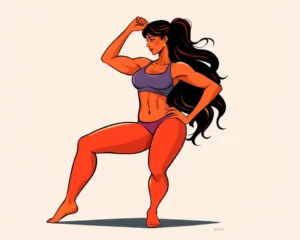Halle Berry, the ageless actress known for her dedication to health and fitness, has recently shared insights into her evolving workout routine as she navigates menopause. In a conversation on The Tamsen Show podcast, Berry revealed that she’s swapped her beloved cardio for what she calls a “boring” but necessary routine of heavy weightlifting. This shift isn’t just about aesthetics; it’s a strategic move to maintain muscle mass, manage diabetes, and stay strong during this transformative stage of life.
Why Weightlifting? The Science-Backed Benefits for Menopause
Menopause brings about significant hormonal changes, particularly a decline in estrogen levels. This decline can lead to a cascade of effects, including:
- Loss of Muscle Mass: Reduced estrogen can accelerate muscle loss, impacting metabolism and strength.
- Decreased Bone Density: Lower estrogen levels can weaken bones, increasing the risk of osteoporosis.
- Increased Risk of Heart Disease: Estrogen plays a role in heart health, and its decline can elevate the risk of cardiovascular issues.
- Mood Changes: Hormonal fluctuations can contribute to anxiety, low mood, and sleep disturbances.
Weightlifting, or strength training, emerges as a powerful countermeasure to these challenges. Here’s how it helps:
- Builds and Maintains Muscle Mass: Strength training stimulates muscle protein synthesis, helping to preserve and even increase muscle mass. This is crucial for maintaining a healthy metabolism and overall strength.
- Strengthens Bones: Weight-bearing exercises like weightlifting put stress on bones, signaling them to become denser and stronger, thus reducing the risk of osteoporosis.
- Improves Heart Health: Strength training can improve cardiovascular health by lowering blood pressure, improving cholesterol levels, and enhancing blood vessel function.
- Boosts Mood and Reduces Stress: Exercise, including weightlifting, releases endorphins, which have mood-boosting and stress-reducing effects.
As personal trainer Kate Rowe-Ham explains, Halle Berry is doing “exactly the right thing for her body at this stage” by focusing on heavy lifting.
Halle Berry’s Evolving Fitness Philosophy
Berry’s fitness journey has been marked by adaptability and a focus on overall well-being. Initially, she relied heavily on cardio exercises like running and cycling. However, as she’s entered menopause, her priorities have shifted.
“I used to do a lot of cardio,” Berry admitted. “Right now, I’m trying to put muscle mass on, so I lift weights now, and I never used to lift weights before. I only did my own body weight and cardio like cycling and running. Now I just do pretty much boring – what I find boring – but it’s necessary for this stage of life. Really just heavier weights than I’ve ever lifted, and I do it probably two days a week at least.”
Berry emphasizes that her goal isn’t to become “muscly” but to “stay healthy” and “manage my diabetes”. She’s found that lifting heavy weights helps her maintain lean muscle mass, which is crucial at this stage of life.
Lifting Heavy: What Does It Really Mean?
Lifting “heavy” doesn’t mean maxing out every time you hit the gym. Instead, it means choosing weights that challenge you within a specific rep range. Female physiologist Dr. Stacy Sims recommends keeping reps low (6-8) and focusing on 3-5 sets. This approach allows you to lift heavier, which provides more stimulation for your central nervous system (CNS).
“[Less] oestrogen – which plays a big role in muscle repair – during perimenopause means your muscles lose strength. Keep your reps low, and shoot for three to five sets of six to eight reps; fewer reps mean you can lift heavier, meaning more stimulation for your central nervous system (CNS),” she says. “We typically rely on oestrogen to recruit muscle fibres and build strength, so you want to teach your CNS to pick up some slack.”
The key is to find a weight that feels challenging after a few repetitions but doesn’t compromise your form. Proper form is essential for preventing injuries and maximizing results.
Sample Halle Berry-Inspired Dumbbell Workout
Want to train like Halle Berry? Here’s a sample menopause-friendly dumbbell workout you can try:
Warm-Up (Each Stretch for 60 Seconds)
- Around the world, stretch (each side)
- Frog squat
- Skipping
Workout (6-8 Reps Per Exercise, Repeat Circuit 3-5 Times)
- Dumbbell Arnold press + jump squat
- V-ups + dumbbell overhead press
- Jumping jack + burpee
- Jump squat + dumbbell overhead press
- V-tucks + dumbbell overhead press
- Jump squat + dumbbell front raise
Important Considerations:
- Rest: Rest for 45 seconds between exercises and 2-3 minutes between rounds.
- Weight Selection: Choose weights that challenge you while maintaining proper form.
- Listen to Your Body: Don’t push yourself too hard, especially when starting. Adjust the weight and reps as needed.
- Consult a Professional: If you’re new to weightlifting or have any underlying health conditions, consult a certified personal trainer or healthcare provider before starting a new workout routine.
Beyond Weightlifting: A Holistic Approach to Menopause Fitness
While weightlifting is a cornerstone of Halle Berry’s current fitness routine, it’s important to remember that overall well-being encompasses more than just one type of exercise. A holistic approach to menopause fitness includes:
- Cardiovascular Exercise: While Berry has reduced her cardio, it’s still an important component of overall health. Aim for at least 150 minutes of moderate-intensity cardio per week, such as walking, jogging, swimming, or dancing.
- Balance and Mobility Exercises: Exercises like yoga, Pilates, and Tai Chi can improve balance, flexibility, and reduce stress levels.
- Nutrition: A balanced diet rich in fruits, vegetables, lean protein, and healthy fats is essential for managing menopause symptoms and maintaining overall health. Berry, who manages diabetes, focuses on a diet with moderate carbs and ensures she gets 16 essential vitamins daily.
- Rest and Recovery: Getting enough sleep and allowing your body to recover after workouts is crucial for muscle growth and overall well-being.
- Mental Health: Menopause can impact mental health, so it’s important to prioritize self-care practices like meditation, mindfulness, or spending time in nature. Halle Berry emphasizes the connection between physical fitness and emotional well-being.
- Stay Active: Incorporate movement into your daily life. Movement snacking during your day can be as simple as doing some squats while waiting for the kettle to boil and standing on one leg as you brush your teeth.
The Importance of Adapting and Evolving
Halle Berry’s fitness journey highlights the importance of adapting and evolving your routine as your body changes. What worked in your 20s and 30s may not be the most effective approach during menopause. By listening to her body, consulting with experts, and embracing new challenges, Berry has found a fitness routine that supports her health and well-being during this transformative stage of life.
“I have to do things differently,” Berry explained. “I used to do a lot of cardio – right now, I do no cardio. I’m trying to put muscle mass on, so I do lift weights now, and I never used to lift weights before.”
Exercise: A Key to Managing Menopause Symptoms
Exercise is proven to be an effective method for reducing menopausal symptoms, decreasing bone loss, and increasing muscle strength in menopausal women. Regular physical activity, including resistance exercises, aerobic training, stretching exercises, and relaxation promotes well-being, prevents osteoporosis by keeping cartilage tissue and bones stronger, decreases the risk of chronic diseases, and helps to maintain proper body weight and prevent gradual body weight gain.
Conclusion: Embrace the “Boring” for a Stronger You
Halle Berry’s “boring” weightlifting routine may not be the most glamorous, but it’s a testament to the power of strategic exercise for managing menopause and maintaining overall health. By embracing strength training, prioritizing a holistic approach to well-being, and adapting to the changing needs of her body, Berry is an inspiration to women everywhere. So, ditch the idea that fitness has to be flashy and embrace the “boring” – your body will thank you for it.







